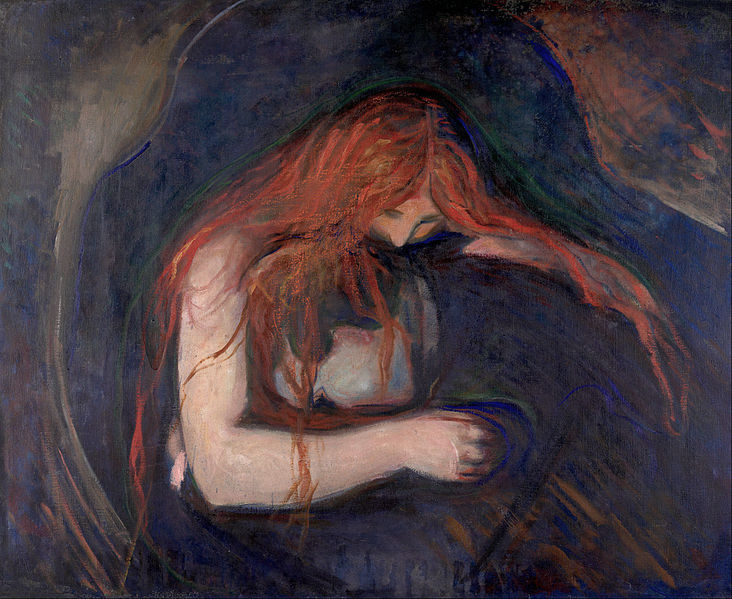
Edward Munch – ‘Vampire’
This article explores six non-invasive pain relief techniques that I have learned from the legendary energy medicine practitioner and teacher Donna Eden. If you are experiencing pain, I encourage you to experiment with these techniques and see what works for you. I hope you will find some of them helpful, and if you do, please share them with others.
The Nature of Pain
Physical pain, in its various forms and degrees, can range from uncomfortable, unpleasant, to incapacitating and debilitating.
However unwelcome and inconvenient pain always is, it is a useful tool for recognising that our body needs our conscious attention to get things back to normal, and possibly avert a much worse health issue.
Pain insists very clearly that we should start taking care of our body. If we don’t get pain, we might not be motivated enough to take care of our body through healthy diet and exercise etc. But when pain strikes, we can be fast enough to try and get ourselves better. To paraphrase Marcel Proust, we make promise to kindness and knowledge, but we obey pain.
Most of us immediately reach for painkillers, or rush to the doctor or a pharmacy to get some, so we can start pain-free again. What was taken for granted before – our normal state without pain, is now regarded as something so desperately desired that we’d give just anything to get it back.
Using Energy to Diminish Pain
Although painkillers can be highly effective in diminishing the pain, in most cases they don’t cause the actual healing – they don’t really treat the underlying issue behind the pain. Through working with energies, we can often achieve results that are much more beneficial to our body then just numbing the pain with chemicals. What’s more, the results of such treatments can be long-lasting.
Pain As Congested Energy
One of the brilliant things about using energy for treating pain is that when we free the stuck / congested energy in the body, the pain often diminishes very quickly and noticeably. And to move the congested energy is often easier than people realise!
Also, stimulating acupuncture points can often increase pain-suppressing endorphins, and release opioid peptides, which are highly effective in relieving pain associated with autoimmune diseases, postoperative discomfort, period cramps, lower back pain, tendonitis, etc.
There are a number of techniques to diminish pain; here are a few examples of the techniques I’ve used with success:
1.Breathing Out The Pain
This is one of the simplest techniques which can be combined with other more complex ones, but it can be helpful even on its own. Since energy can be moved by breathing, we can gain some degree of control over our pain by breathing in through our nose (with mouth closed), an breathing out through our mouth.
Exhaling can release some energy involved with the pain. It’s good to visualise that on the outbreath we are releasing all our physical tension from our head to your toes.
This technique was also popularised by a French obstetrician Fernand Lamaze, who in the 1950s introduced a method called psychoprophylaxis, also known as ‘Lamaze breathing technique’, which helps women in labour to better manage contraction pains, through the use of controlled breathing and conscious relaxation.
The best way to remember this technique is to think of smelling a rose (for the inbreath) and then blowing out a candle (for the outbreath).
2.Tapping
Tapping is another effective technique which is familiar to the body, as it resembles the heartbeat. You’ll be freeing energy in the congested area. This technique is specially good to use for aching muscles – e.g. after carrying heavy luggage.
If, for example, you experience pain in your shoulders, you can use your fingers or a hairbrush to do the tapping. (I particularly like using a wooden hairbrush.) Keep tapping for about a minute, while breathing in through your nose and out though your mouth, visualizing the pain being tapped out of the sore area.
3. Stretching
If you gently stretch the area around the epicentre of the pain, you can often experience some relief. This is due to smoothing, evening out, or freeing the energy that has over-accumulated at the site where you feel the pain. (This technique is obviously not suitable for open wounds or burnt skin)
4. Pinching (‘Spindle Cell Mechanism’)
Using your thumb and your forefinger, VERY lightly pinch the skin around the painful area. This super-light pinch is powerful enough to free clogged energy in the painful area through communicating with your nervous system, informing it that pain is no longer necessary.
5. Siphoning the Pain
As the left side of our body receives energy, and the right sight releases it, this method can provide considerable relief from pain by placing our left hand on the painful area of the person we want to help. Our left hand will be pulling the excess energy from the sore area – ‘siphoning’ it off the other person, and thus providing him/her with relief. The energy will be draining off your right hand. Hold your right hand away from your body, facing down, and out.
Although this doesn’t often happen, it’s good to be aware of the risk of the energy of the other person being caught in your own body while performing this technique; you may start feeling pain yourself. This happened to me recently when I was treating my husband.
If this happens, stop at once and shake your hands off energetically. (I did exactly that, and then, to free my right hand from pain completely, did another healing technique on myself, described below. My pain was gone in less than ten minutes.)
6. Zone Tapping
One of the ways to stop or diminish pain is a technique called Zone Tapping. This technique is also practised in foot reflexology. I have used this technique on quite a few people including myself, and I’m happy to say that in most cases this simple treatment resulted in noticeable pain relief. According to this discipline, the body is divided into 6 zones (Figure 1 and 2).
First, you first locate the source of the pain on your body, then look it up on the diagram and determine on which zone the point of your pain lies. (This technique is more suitable for localised pain, rather than diffuse, widely spread pain)
You’ll then tap specific points on your wrists or your ankles, depending on which zone your pain is, and also whether it is on the front or the back of your body.
The softer parts of the body, which are in front your body and inside the limbs, (where hair doesn’t grow as easily) are classified as YIN.
This also includes the bottoms of your feet and the palms of your hand. It is easy to remember the yin parts especially when we think of the hairless areas of the arms and legs.
The slightly tougher areas of your body, especially the back, are considered YANG. This also includes the backs of your hands, the tops of your feet, the outsides of your limbs (where hair can grow) and the back of your head and neck.
To practise the zone tapping, follow these steps:
1. Locate your pain on your body and then look it up on the map of the body (Figures 1 and 2)
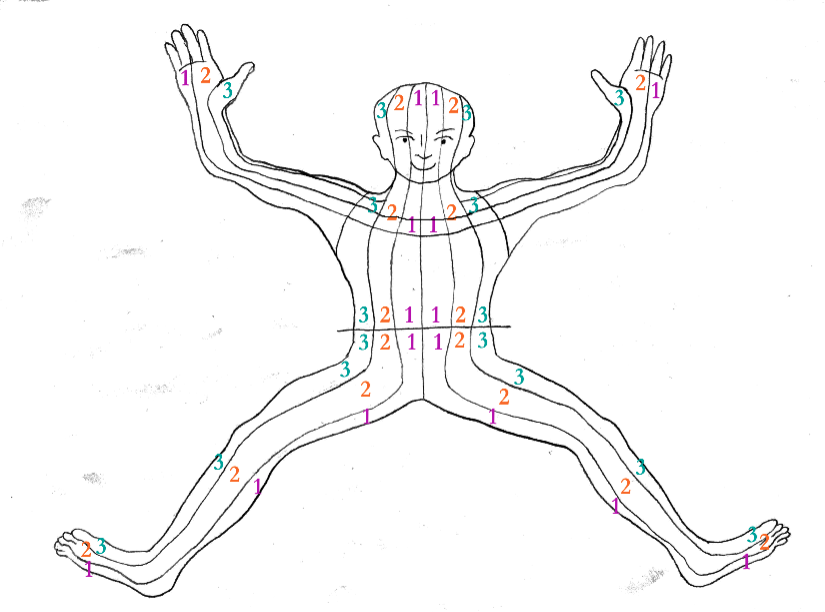
Figure 1
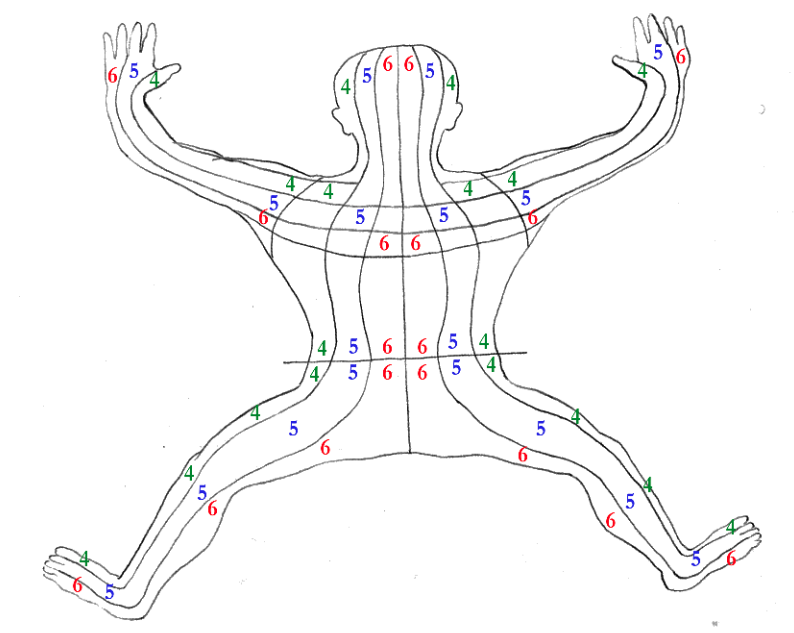
Figure 2
2. Find the number of the zone which flows through the area of your pain.
3. If your pain is anywhere above your waist, you will be tapping one of the allocated points on your wrist;
If the pain is anywhere below your waist, you will be tapping one of the corresponding points on your ankle.
(Note: ‘A’ in the diagram means Ankle, and ‘W’ means Wrist.
If your pain lies on the front (YIN) part of your body, you’ll be tapping on the INSIDE of your ankle or your wrist. (Remember: Yin = Inside)
If the pain lies on the back (YANG) of your body, you’ll be tapping the OUTSIDE of your ankle or your wrist. (Remember: Yan = Outside)
4. Find the point on the wrist (for pain above the waist) or ankle (for pain below the waist) that corresponds with the point of your pain. (Figures 3 and 4)
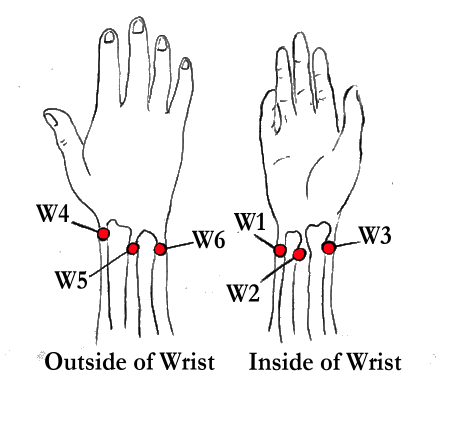
Figure 3
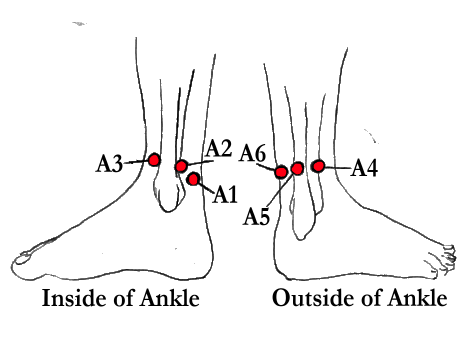
Figure 4
For example, if your pain is on the front of your head, near the centre, it will be in zone 1.
As it is above the waist, we’ll be tapping on the wrist.
And as it is located on the front (YIN) of the body, we’ll be tapping inside the wrist.
Then we’ll find W1 (Wrist 1) point on the diagram.
The Tapping Procedure:
1. Tap the point about ten times, and then stop for ten seconds.
2. Tap for 1,5 minutes (90 seconds) more. I usually tap in a one second interval and count to ninety.
3. In about ten minutes the pain should ease or disappear. If it doesn’t, do the same procedure on the opposite side of the body.
Note: If you are unsure whether you were tapping the correct point, you can energy test each of the points first. Press each of the points, and at the same time push the treated person’s arm (which is extended in 90 degrees from the body) down.
The person will lose energy on the zone that needs to be tapped and will remain strong on the other ones.
Back and Shoulder Pain
If you are suffering from back or shoulder pain, I recommend you visit my article ‘How to Relieve Chronic Back Pain.’
I hope you’ve found this article helpful. If you have any questions or comments, leave a comment below. I wish you a pain-free day!

BY LUCIE DUN
This site has been (very happily) built with DIVI, by Elegant Themes.
Disclaimer: This page contains affiliate links. This means that if you decide to make a purchase through my links, I will earn a small commission at no extra cost to you. The complete Affiliate Disclosure can be accessed here. If you’d like to learn more about affiliate marketing, check out my favourite platform for online marketers. Thank you for visiting!
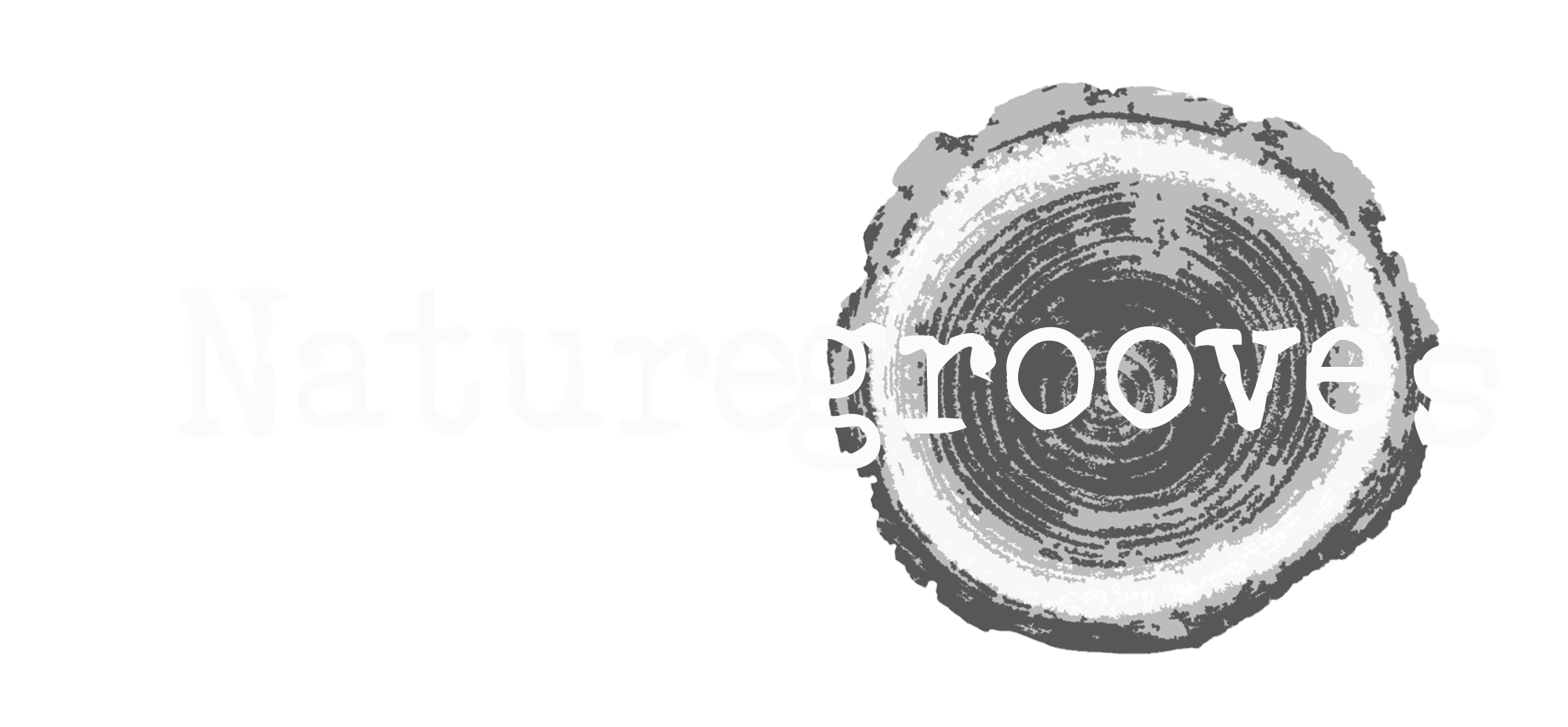




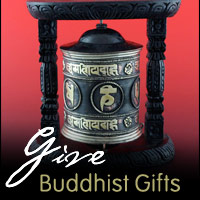
I love how when I learn something new or when I’m reading up on something that it manifests itself again and again. I just learned about tapping recently and blam! here it is again in your post! Thank you for the helpful diagrams too. That’s so interesting!
I just purchased a backnobber not too long ago and didn’t even think about it being used to clear bad energy from my back. I’ve used it a couple of times but I think I’ll try lying down on the floor as you suggested so it can really get into the muscles. Thanks for all of the advice you give for naturally alleviating pain.:)
Thank you, Jennifer, that’s spot on! We could call it synchronicity 🙂 I have very similar experiences. It seems that it there’s something that really resonates with you (e.g. tapping), then your own frequency will somehow align with similar energies and attract more of that stuff into your life. All this field of Energy Medicine and tapping suddenly started flooding into my life last year out of the blue. If someone asked me about my plans a year before that, I’d have NO idea about all this. I love how sometimes we don’t really have to plan our life to every detail, it can unfold on its own so creatively if we allow it.
I’ve never heard about the backnobber, which you mention in the other article on relieving back pain, but it seems to be a helpful product. My friend suffers from back pain sometimes, so I’ll definitely share this post. Is there a video to show how it works?
Thank you for sharing this! 🙂 I’m sure your friend will love it. I’ve added more photos of me ‘in action’, so you can see the main ways of using it, and further down I’ve also inserted a video from the original manufacturer with more info. Enjoy!
I really this blog it is so deep. Whats more I am familiar with the concept of prana(energy). Congested areas that need to be unblock so energy can flow reducing the pain makes sense to me. Prana flowing all through the body if obstructed means certain areas of the body a devitalized. The abnormal flow of energy can lead to pain and even disease. I believe what you say about exercises, breathing, stretching, and so on natural pain killers, because increasing the dopamine increases pleasure and cuts down pain. Another way to put is when one does those exercises it makes the flow of energy more global(entire body) creating greater internal harmony. This article resonates with me.
Really glad to hear that, Linda, thank you for your kind words. Pranic breathing is so underestimated / unknown in western society. Unblocking congested energy can indeed lead to deep healing. This can also be manifested during chakra balancing and clearing. There is so much information stored in each layer of every chakra, and oftentimes we can uncover some emotional baggage from the past which was in the way of the healing. This stuff really fascinates me, it reminds me of CD-ROM discs with information stored in them.. 🙂
Never knew pain medications do not usually cause the actual healing. I usually experience back pain on my mid-back to one side of it and wasn’t sure of how to get rid of it.
Will definitely try out breathing out the pain and tapping techniques to see how I feel. Thereafter, decide to opt for the Backnobber II.
Seems like I found my healing through this post already.
Great you feel like giving the Zone-Tapping a go. It is very relaxing and in many cases effective. It’s also good to practice slow and deep breathing while doing the tapping.
I’ve also just updated my other post on back pain relief with yet another device that really worked for me in terms of lower back pain – a simple, yet powerful strap/ back support called ‘Back-Up’ (made by ‘Nada Chair’). It’s worth having a look at. Here’s the link to the article: https://naturegrooves.com/how-to-relieve-chronic-back-pain